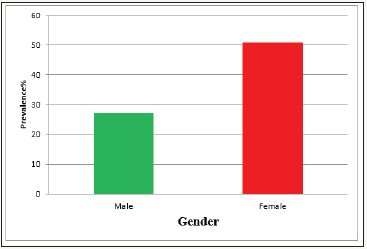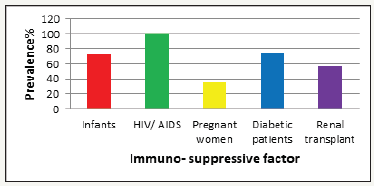- Submissions

Full Text
Advancements in Bioequivalence & Bioavailability
Prevalence of Cryptosporidiosis Among Selected Group of Sudanese Patients
Mosab Nouraldein Mohammed Hamad*
Department of Medical Laboratory Sciences, Elsheikh Abdallah Elbadri University, Sudan
*Corresponding author:Mosab Nouraldein Mohammed Hamad, Department of Medical Laboratory Sciences, Elsheikh Abdallah Elbadri University, Sudan
Submission: August 07, 2018;Published: September 21, 2018

ISSN 2640-9275 Volume1 Issue5
Abstract
Cryptosporidium parvum was firstly identified in 1912 in murine intestines. The first human cases were described only in 1976. In the early 1980s, large numbers of cases were noted to be associated with the emerging epidemic of acquired immunodeficiency syndrome (AIDS). This was a cross-sectional hospital-based study. It was conducted in Alribat University hospital, Khartoum State and aimed to estimate the distribution of Cryptosporidium parvum among the patients in the study area. 120 stool samples were collected and analyzed by Modified Ziehl-Neelsen (Zn) Technique. Results shows that, C. parvum was more prevalent among the female patients (50.8%) than the males (27.3%). It was more prevalent among the age group >50 years old (62.5%). Furthermore, the parasite was more prevalent among HIV/AIDS patients (100%). The study concludes that C. parvum was more prevalent among the female patients and among the age group >50 years old and HIV/AIDS patients. The study recommends the routine examination of HIV/AIDS patients for C. parvum infection.
Keywords: Cryptosporidium parvum; Sudanese patients; Diarrhea
Introduction
Cryptosporidiosis is an opportunistic infection caused by Cryptosporidium species. Cryptosporidium parvum is a protozoan parasite that causes gastrointestinal illness and is transmitted by ingestion of Oocysts excreted in human or animal feaces and modes of transmission include person to person, animal to person, by exposure to contaminated surfaces, and by ingestion of contaminated food or water [1]. Protozoan parasites of genus Cryptosporidium were first identified in the stomach of mice. The species name Cryptosporidium parvum was proposed in 1912 to describe parasites identified in murine intestines. The first human cases were described only in 1976.5 In the early 1980s, large numbers of cases were noted to be associated with the emerging epidemic of acquired immunodeficiency syndrome (AIDS). Cryptosporidium parvum, although, a common parasite in animals, was relatively unknown as a human pathogen before the Milwaukee outbreak in 1993, where an estimated 403,000 residents of the greater Milwaukee, Wisconsin, area with population of approximately 1.61 million people became ill when an ineffective filtration process led to the inadequate removal of Cryptosporidium oocysts in one of two municipal water treatment plants. The signs and symptoms of the disease in both patients are the same but the course and severity of the disease in these groups of patients are largely different. It causes a self-limited diarrhea syndrome in immunocompetent persons while in immunocompromised patients, it causes much more serious clinical signs, being manifested as prolonged debilitating diarrhea, weight loss, fever, and abdominal pain, with occasional spread to the trachea [2].
Cryptosporidium species are recognized globally as important causes of diarrhoea in children 8 and adults and is a leading cause of persistent diarrhoea in developing countries.9 In Nigeria; it is a significant cause of diarrhoea. In a study by 10 where total of 354 patients were examined for the presence of C. parvum infection, diarrhoea was present in 129 of the patients and with 225 of these patients having no diarrhoea. Among those with diarrhoea, 21 had C. parvum while 11 who had no diarrhoea but had C. parvum [3].
Literature Review
In Abuja [4], Nigeria, stools of a total of 354 patients were examined for the presence of C. parvum infection. The females were more infected than the males, 18 (10.84%) versus 14 (7.45%). In the individuals with diarrhea, the age group of 41-50 years had the highest prevalence of C. parvum infection (3, 33.33%), followed by those that >50 years of age (2, 20.0%), and 31-40 years (3, 18.75%). In non-diarrhea individuals, those that were aged 31-40 years had the highest prevalence of C. parvum infection, (4, 10.53%), followed by those that were aged >50 years, (1, 7.69%). The mean age of the patients was 22.96+0.1 years (range 1-90 years; SD 0.93), with 188 males and 166 females. Diarrhea was present in 129 patients, and 225 had no diarrhea. In 16.28% (21/129) of the patients with diarrhoea, Cryptosporidium parvum was found, while in the control group 4.89% (11/225) was found to have the parasite. Among those with diarrhea, 21 had C. parvum, while 11 did not have diarrhea but had C. parvum. Yunusa, (2015) in a Tertiary Health Institution, Nigeria found that, out of the 74 males investigated for C. parvum 21 (28.3%) were positive for the parasite representing 36% of the total seropositive population sampled. Thirty-seven (37, 34.2%) females tested positive with the parasite representing 63.7%. Fiftysix (56, 56.5%) of the fifty-eight C. parvum ELISA seropositive were obtained from subjects who presented with mucoid diarrhoea.
Rationale
Cryptosporidium is a leading cause of persistent diarrhoea in Developing countries. Cryptosporidiosis is widespread and affects all ages, and documented evidence indicated the parasite as a cause of Diarrhoea in 95 countries. Cryptosporidium is recognized as a significant and widespread cause of diarrheal illness in both immunocompetent and immunosuppressed hosts. Cryptosporidium may cause severe symptoms in persons with weak immune systems. Cryptosporidium transmission occurs at a high frequency in day care centers where children are clustered within classrooms, share toilets and common play areas [5].
Objectives
General objective
To estimate the distribution of C. parvum among patients attending Alribat University hospital, Khartoum State, Sudan.
Specific objectives
A. To compare the distribution of C. parvum among patients according to gender.
B. To compare the distribution of C. parvum among patients according to age.
C. To compare the distribution of C. parvum among patients according to immune suppressive factor.
Materials & Methods
Study design
This was a cross-sectional hospital-based study to estimate the distribution of C. parvum among patients attending Alribat University hospital, Khartoum State, Sudan.
Study area
The study was conducted in Alribat University hospital, Khartoum State, Sudan.
Study duration
The present study was conducted throughout the period from 1/1/2017 to1/4/2017.
Study population
Male and female patients (of different ages) attending Alribat University hospital, Khartoum State, Sudan.
Sample size
Stool samples were obtained from 120 samples were randomly selected.
Specimen collection
Stool specimens were collected from all participants. The specimens were collected following the quality control procedures. They were fixed with 10% Formol water v/v. for Z.N. staining technique, (Elsenga, 1992).
Stool Examination
Macroscopical examination of stool
Faeces were examined macroscopically for faecal consistency and color. These may vary with diet, but certain clinical conditions associated with the parasite presence may show wet or loose stool consistency or even diarrhea. The faeces were also examined for the presence of tapeworm segments or other helminthes (Fox, 1992).
Modified Ziehl-Neelsen (Zn) Method
Reagents
A. Carbol fuchsin stain
B. Malachite green stain
C. Acid alcohol 1%v/v
Method
A smear was Prepared from the feacal specimen it was airdried. Then the smear was fixed with methanol for 2 minutes, it was stained with unheated carbol fuchsin for 15 minutes. the stain was washed off with water. The smear was decolorized with 1% acid alcohol for 10 seconds. And washed off with water. Thereafter, the smear was counterstained with 0.5% malachite green for 30 seconds and washed off with water and the slide was stand in a draining rack to dry. The smear was examined microscopically for Oocysts, using the oil immersion objective lens to detect and identify them [3].
Statistical analysis
After gathering the data including sex, age and parasite species, the data were analyzed by SPSS 11.0 based on the study purposes. Chi-square test was used and t-test was used to compare quantitative variables [6].
Ethical consideration
All participants were informed about the objectives of the study and they were consenting to be involved in it.
Results
The distribution of C. parvum among patients attending Alribat University hospital according to the gender:
By using Modified Ziehl-Neelsen (Zn) method Table 1, the total distribution of C. parvum was 40%. The study found that C. parvum was more prevalent among the females (50.8%) than the males (27.3%) Figure 1.
Figure 1:Showing The distribution of C. parvum among patients attending Alribat University hospital according to the gender.

Table 1:Showing The distribution of C. parvum among patients attending Alribat University hospital according to the gender.

The distribution of C. parvum among patients attending Alribat University hospital according to the age:
The study found that C. parvum was more prevalent among the age group >50 years old (62.5%) followed by age group 5-10 years old (55%) Table 2. While it was less prevalent in age group 41 -50 years old (12.5%) Figure 2.
Figure 2:Showing The distribution of C. parvum among patients attending Alribat University hospital according to the age.

Table 2:Showing the distribution of C. parvum among patients attending Alribat University hospital according to the age.

The distribution of C. parvum among patients attending Alribat University hospital according to the immuno- suppressive factor:
The study found that C. parvum was more prevalent among HIV/ AIDS patients (100%) followed by diabetic patients (73.7) and infants (73.3%) Table 3. While it was less prevalent among pregnant women (35.7%) Figure 3.
Figure 3:Showing the distribution of C. parvum among patients attending Alribat University hospital according to the immuno- suppressive factor.

Table 3:The distribution of C. parvum among patients attending Alribat University hospital according to the immuno- suppressive factor.

Discussion
The pathogen Cryptosporidium parvum has contributed significantly to diarrheal disease particularly in countries of the world where a declining in hygiene can be a persistent problem, considering Cryptosporidium an emerging protozoan and a leading cause for hospital admission at Alribat University hospital, Khartoum State, Sudan. The acid fast was easily and cheaply carried out in a laboratory setting. In this study, Cryptosporidium are identified among patients attended Alribat University hospital, Khartoum State to find that the total prevalence was 40%. it was more than the findings of [7], who found that the total prevalence in Keffi, Nasarawa State, Nigeria. Was only 15%. Our study found that C. parvum was more prevalent among the females (50.8%) than the males (27.3%). This agreed with the findings of Abrahamsen et al. [8], In kenia who reported that females were more affected (15.3%), this may be explained by the fact that, large numbers of females attend the hospitals than males. The study found that C. parvum was more prevalent among the age group >50 years old (62.5%) followed by age group 5-10 years old (55%). Contrary [9] reported that Cryptosporidium parvum was observed to be a threat within the ages 10-19 years old and in the sexually active age group of 30-39 years. The study found that C. parvum was more prevalent among HIV/ AIDS patients (100%). Cryptosporidium parvum in immunocompromised patients, such as those with HIV or those undergoing immunosuppressive therapy, may not be self-limiting, leading to dehydration, emaciation and, in severe cases, death. This was in agreement with the finding of Srisuphanunt in Thailand who found that the highest prevalence of C. parvum was among HIV patients 18.4%.
Conclusion
This study concludes that the total prevalence of C. parvum was 40%. The parasite was more prevalent among the females than the males [10]. The parasite was more prevalent among the age group >50 years old followed by age group 5-10 years old. The parasite was more prevalent among HIV patients.
Recommendations
A. Improvement of the family and child knowledge about the mode of transmission of C. parvum.
B. Chlorination of drinking water to prevent the transmission of the parasite.
All individuals living with HIV should have a routine examination for C. parvum infection.
References
- Colebunders R, Lusakumi K, Nelson AM, Gigase P, Lebughe I, et al. (1988) Persistent diarrhea in Zairian AIDS patients: An endoscopic and histological study. Gut 29(12): 1687-1691.
- Mahajan M, Mathur M, Talwar C (1992) Cryptosporidiosis in east Delhi children. Trop Parasitol 7(1): 18-28.
- Shalid NS, Rahawan ASMH, Anderson BC, Mara LJ (2000) Cryptosporidium as a pathogen for diarrhea in Bangladesh. Trop Geogr Med 39(3): 265-270.
- Igbe M, J Ajayi J, Anyanwu G, Igwillo C, Ameh C, et al. (2012) Cryptosporidium parvum in patients with and without diarrhea in abuja, Nigeria. The Internet Journal of Health 13(1).
- Manabe YC, Clarks DP, Moore RD, Lumadue JA, Dahlman HR, et al. (2003) Cryptosporidiosis in patients with AIDS: correlates of disease and survival. Clin Infect Dis 27(3): 536-542.
- Pedersen C, Danner S, Lazzarin A, Glauser MP, Weber R (1996) Epidemiology of cryptosporidiosis among European AIDS patients. Genitourine Medicine 72(2): 128-131.
- Bogarts J, Lepage P, Rouvroy D, Vandepitte J (2011) Cryptosporidium spp: a frequent cause of diarrhea in Central. Africa Journal of Clinical Microbiology 20(5): 874-876.
- Abrahamsen MS, Templeton TJ, Enomoto S, Abrahante JE, Zhu G, et al. (2004) Complete genome of the apicomplexan, Cryptosporidium parvum Science 304(5669): 441-415.
- Akwa VI, Bimbol NI, Samali KL, Marcus NB (2007) Geographical project in Nasarawa state, Nigeria. Onnivi Printing and publication company limited, Keffi, Nigeria, p. 5.
- Smith G, Van Den Ende J (1986) Cryptosporidiosis among black children in South Africa. Journal of Infection 13(1): 25-30.
© 2018 Mosab Nouraldein Mohammed Hamad. This is an open access article distributed under the terms of the Creative Commons Attribution License , which permits unrestricted use, distribution, and build upon your work non-commercially.
 a Creative Commons Attribution 4.0 International License. Based on a work at www.crimsonpublishers.com.
Best viewed in
a Creative Commons Attribution 4.0 International License. Based on a work at www.crimsonpublishers.com.
Best viewed in 







.jpg)






























 Editorial Board Registrations
Editorial Board Registrations Submit your Article
Submit your Article Refer a Friend
Refer a Friend Advertise With Us
Advertise With Us
.jpg)






.jpg)














.bmp)
.jpg)
.png)
.jpg)










.jpg)






.png)

.png)



.png)






